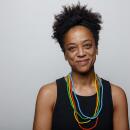Review: Margo Jefferson reveals life inside the black elite in ‘Negroland’
At a time when black people are disrupting presidential campaign speeches nationwide in an effort to be recognized as human beings, “Negroland,” the new memoir by Pulitzer Prize-winning cultural critic Margo Jefferson, offers poignant insight into what it means to have been raised in the sheltered Kingdom of Negroes that Jefferson refers to as “the Third Race” — upper-middle-class African Americans who, among a long list of other things, “refused to be held back by the lower element.” Particularly as that “lower element” — then and now — likely translates to the black people who are getting killed in staggering numbers by police violence, who earn on average far less than their white counterparts, who live unveiled and unprotected in the face of rampant systemic racism. In other words, most of black America.
This oddly tenuous privilege, hard-won and yet still as easily diminished or destroyed as any other black experience, is clearly something Jefferson has grappled with — in turns proud and ashamed. Throughout the book, there is this sense of ghost-like longing, a distant ache to reconcile a childhood without having to bare one’s soul in the process. Subsequently, “Negroland” reads less like a memoir and more as a studious inquiry into a cultural phenomenon — Chicago’s black bourgeois during the 1950s and ‘60s — with glimpses into the life of a light-skinned black girl trying to be seen but not too vividly.
Jefferson, a uniquely curious and remarkably accomplished journalist and essayist, is at her best when she observes the experiences of others as an expression of self-awareness. That’s not lost on Jefferson herself, who writes: “Clever of me to become a critic.”
SIGN UP for the free Essential Arts & Culture newsletter >>
“We critics scrutinize and show off to a higher end,” she continues. “For a greater good. Our manners, our tastes, our declarations are welcomed. Superior for life. Except when we’re not.” The weight and sentiment of that last sentence winds its way in and around the book’s narrative — its tenor superior, except when it’s not; Jefferson’s own life as a member of the black elite, except when it’s not.
Jefferson’s father was a pediatrician, and her mother a socialite — described as: “Light brown skin. A Claudette Colbert cap of dark hair. Beneath her black sunglasses a hooked nose asserted itself.” They lived in well-respected parts of Chicago, where Jefferson and her older sister, Denise, received a private education at the reputable University of Chicago Laboratory Schools. The two were also the first Negro girls to attend the historically celebrated Palos Park summer camp in the forest preserves outside of Chicago, where they hiked and canoed, made friends and enjoyed themselves freely in the company of their white peers, until the next summer when Jefferson is rather abruptly asked to talk to the new black kid to help him fit in.
“I hate it when I’m supposed to be having fun and Race singles me out for special chores and duties,” she writes, with chilling detachment.
An upbringing that required that Jefferson “be circumspect: impeccable but not arrogant; confident yet obliging; dignified, not intrusive” also bred a striking disconnect from other black folks on a spectrum of varying reference points. Jefferson recalls how she and her sister giddily mockingly imitated the word “I’se” in Hughes’ poem “Mother to Son”: “We read it like our favorite characters on Amos ‘n’ Andy — Calhoun (Denise), the hyperactive, scheming, bloviating attorney-at-law, and Lightning (me), behind everyone’s physical or mental beat with his hapless limbs, crossing eyes, and high throated meandering syllables.” The girls are verbally reprimanded by their mother, who goes on to read the poem aloud as it should be read.
Later, when Jefferson arrives at college during the ‘60s and discovers black radicalism, she identifies the cultural divide created by her upbringing and which now evokes the necessity to “take blunt weapons to whole parts of oneself and hack away.”
But perhaps most harrowing during these years of radical awakening is Jefferson’s struggle with depression, which she describes in what becomes the only truly unguarded moment in the book — studying suicide notes and practicing daily the act of sticking her head in the oven.
Depression was all well and good, indeed glorified, for white girls, but “Good Negro Girls” were denied such mental-illness musings. “We were to be ladies, responsible Negro women, and indomitable Black Women. We were not to be depressed or unduly high-strung; we were not to have nervous collapses. We had a legacy.”
That legacy — of free Negroes in America over the course of 200 years; the firsts, the finest, W.E.B. Du Bois’ talented 10th, Ida B. Wells and Anna Julia Cooper — provided Jefferson with the mettle to become a renowned critic but also ensured a kind of cordoned-off remove. In “Negroland,” Jefferson is simultaneously looking in and looking out at her blackness, elusive in her terse, evocative reconnaissance, leaving us yearning to know more.
::
Negroland
A Memoir
Margo Jefferson
Pantheon: 256 pp., $25
Carroll is the author of five books, including “Saving the Race: Conversations on Du Bois From a Collective Memoir of Souls.”
More to Read
Sign up for our Book Club newsletter
Get the latest news, events and more from the Los Angeles Times Book Club, and help us get L.A. reading and talking.
You may occasionally receive promotional content from the Los Angeles Times.







